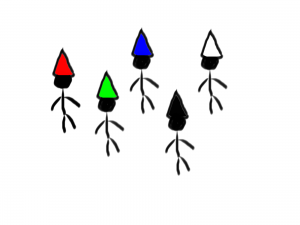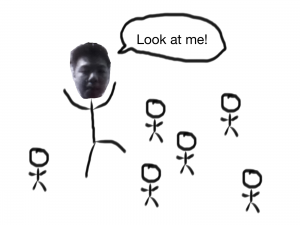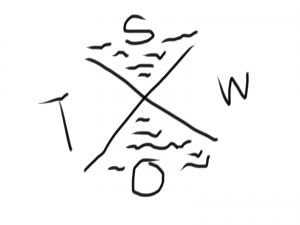My t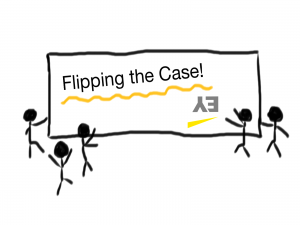 eam is fresh off of our final design solution last week, and I believe it was an accurate representation of everything I’ve learned throughout the entirety of COMM 388. Self-reflection, design strategies, problem solving, prototyping, were just some of the many topics that cumulated in our powerpoint for Ernst & Young.
eam is fresh off of our final design solution last week, and I believe it was an accurate representation of everything I’ve learned throughout the entirety of COMM 388. Self-reflection, design strategies, problem solving, prototyping, were just some of the many topics that cumulated in our powerpoint for Ernst & Young.
After our first go-around of creating a design solution, we received a bit more constructive criticisms than I had hoped for. The customer profile we created wasn’t applicable, the individual pains and gains of the value map were disorganized, and our proposed solution might as well as been boiling the ocean. It was difficult and a little disheartening to recuperate and get myself and the project back on track before the final design solution presentation.
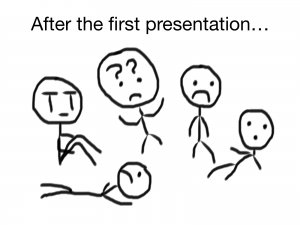 Immediately after our initial presentations in front of EY representatives at the TD tower, the team got together and discussed how we can pivot our design into a more sensible direction. It was at this moment, we decided to be brave and scrap a lot of the progress we’ve made so far and begin the prototyping process again with new feedback and ideas. We went back to the drawing board and reiterated what exactly was the problem statement. This wasn’t an easy pill for me to swallow, since I didn’t exactly embrace the notion of starting over. However, this is simply putting design strategies to use and it was necessary in order to refine our solution to become something more tangible, scalable, and creative.
Immediately after our initial presentations in front of EY representatives at the TD tower, the team got together and discussed how we can pivot our design into a more sensible direction. It was at this moment, we decided to be brave and scrap a lot of the progress we’ve made so far and begin the prototyping process again with new feedback and ideas. We went back to the drawing board and reiterated what exactly was the problem statement. This wasn’t an easy pill for me to swallow, since I didn’t exactly embrace the notion of starting over. However, this is simply putting design strategies to use and it was necessary in order to refine our solution to become something more tangible, scalable, and creative.
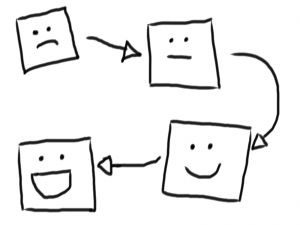 Before this course, I feel I was very adamant in my decision-making process for long-term projects or assignments. I had troubles with applying critique and feedback for early versions (ironic as our proposed solution included a modified version of a critic’s corner) and using that to refine my final solution. My previous mindset was partly because of that I was afraid of the uncertainties in change, and partly because I always fell in love with my initial ideas. The one section of “Value Propositions and Design” which really resided with me and evolved my thinking process was prototyping possibilities, “exploring multiple directions with the same amount of time and energy.” (Osterwalder, A., & Pigneur, Y.) This pushed me into applying a more linear and agile outlook into solving problems.
Before this course, I feel I was very adamant in my decision-making process for long-term projects or assignments. I had troubles with applying critique and feedback for early versions (ironic as our proposed solution included a modified version of a critic’s corner) and using that to refine my final solution. My previous mindset was partly because of that I was afraid of the uncertainties in change, and partly because I always fell in love with my initial ideas. The one section of “Value Propositions and Design” which really resided with me and evolved my thinking process was prototyping possibilities, “exploring multiple directions with the same amount of time and energy.” (Osterwalder, A., & Pigneur, Y.) This pushed me into applying a more linear and agile outlook into solving problems.
We put many brainstorming activities into use, namely role-playing and the game of wearing different hats. Every Monday, we would book a room, host scrum meetings, throw out ideas and watch them bounce off of other team members. The group discussions were more of a blessing than a curse, as the idea generation was invaluable and outweighed the numerous times we had to gather ourselves after getting off topic. The process from start to finish was turbulent, we had disagreements and conflicting visions for the final product. However, I was very proud of everyone’s ability to contribute, and I learned to pose more questions in group activities than before.
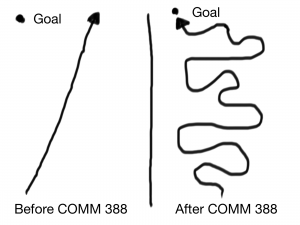 To me, design thinking is the “cycle of understanding customers”, “creating ideas and starting points”, and “prototyping possibilities.” (Osterwalder, A., & Pigneur, Y.) With this, I look at problem-solving in a more holistic manner rather than a linear approach. I will certainly use it as self-reflection (I now love asking “why?” after COMM 388) during the rest of my student and professional career. Design thinking has taught me that is okay, even necessary, to take a step back during the process and reevaluate the course of the project as the whole. It is important to keep questioning up until the very last moment, which is exactly what our group did for our final design solution.
To me, design thinking is the “cycle of understanding customers”, “creating ideas and starting points”, and “prototyping possibilities.” (Osterwalder, A., & Pigneur, Y.) With this, I look at problem-solving in a more holistic manner rather than a linear approach. I will certainly use it as self-reflection (I now love asking “why?” after COMM 388) during the rest of my student and professional career. Design thinking has taught me that is okay, even necessary, to take a step back during the process and reevaluate the course of the project as the whole. It is important to keep questioning up until the very last moment, which is exactly what our group did for our final design solution.
References:
Osterwalder, A., & Pigneur, Y. (n.d.). Value proposition design: How to create products and services customers want.

